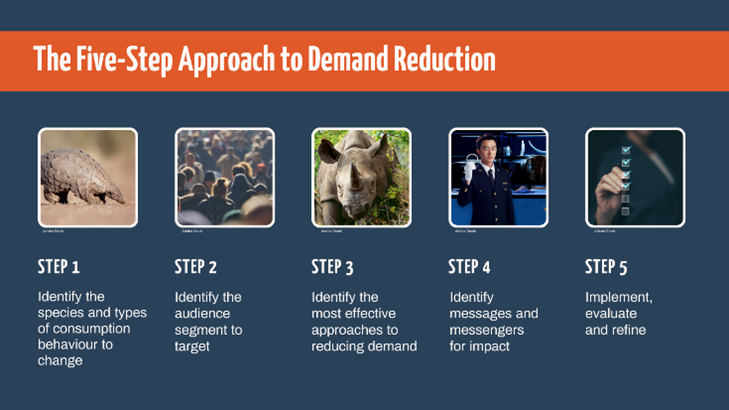
© CITES Secretariat
Dans le contexte de la CITES, la réduction de la demande fait référence aux efforts déployés pour décourager et prévenir l’utilisation ou la consommation de plantes et d’animaux sauvages acquis illégalement alors qu’ils sont inscrits aux Annexes de la CITES, ceci passant notamment par des interventions visant à modifier les comportements.
La réduction de la demande vient compléter les efforts de lutte contre la fraude et les mesures visant à soutenir les moyens d’existence des communautés rurales, dans le cadre de la lutte contre le commerce illégal des espèces inscrites à la CITES.
À sa 17e session (Johannesburg, 2016), la Conférence des Parties à la CITES (CoP17) a adopté la résolution Conf. 17.4, Stratégies de réduction de la demande pour lutter contre le commerce illégal d’espèces inscrites aux annexes CITES. Cette résolution invite les Parties à la CITES à préparer et à mettre en œuvre des interventions de réduction de la demande qui soient bien ciblées, factuelles et spécifiques à une espèce donnée ainsi qu’à un pays donné, en vue de modifier le comportement des consommateurs de manière plus efficace.
À sa 19e session (Panama, 2022), la Conférence des Parties à la CITES (CoP19) a prié les Parties d’appliquer pleinement les Orientations CITES sur les stratégies de réduction de la demande pour lutter contre le commerce illégal des espèces inscrites à la CITES. Ces orientations présentent une approche en cinq étapes, fondée sur la science du changement de comportement, en vue d’exercer un impact plus efficace sur le terrain. Depuis la CoP19, des efforts ont été déployés pour promouvoir l’utilisation de ces Orientations, notamment grâce à des séminaires de formation régionaux et à des projets pilotes dans diverses régions.
Résolutions and Décisions
- Résolution Conf. 17.4 (Rev. CoP19) sur les Stratégies de réduction de la demande pour lutter contre le commerce illégal d’espèces inscrites aux annexes CITES
- Décisions 19.55 to 19.57 sur la Réduction de la demande pour lutter contre le commerce illégal
Actualités et messages vidéo
Documents de réunion
SC78 Doc. 29 - Rapport du Secrétariat à la 78è session du Comité Permanent sur la Réduction de la demande pour lutter contre le commerce illégal
SC77 Doc. 30 - Rapport du Secrétariat à la 77è session du Comité Permanent sur la Réduction de la demande pour lutter contre le commerce illégal
CoP19 Doc. 38 - Rapport du Secrétariat à la CoP19 sur la Réduction de la demande pour lutter contre le commerce illégal
SC74 Doc. 34 - Rapport du Secrétariat à la 74è session du Comité Permanent sur la Réduction de la demande pour lutter contre le commerce illégal
CoP18 Doc. 20 - Rapport du Secrétariat à la CoP18 sur la Réduction de la demande pour lutter contre le commerce illégal
SC70 Doc. 16 - Rapport du Secrétariat à la 70è session du Comité Permanent sur la Réduction de la demande pour lutter contre le commerce illégal
CoP17 Doc. 18.1 - Document de travail soumis par les Etats-Unis à la CoP17 sur la Réduction de la demande pour lutter contre le commerce illégal
Autres ressources
La 2ème Edition de la compilation d'outils ICCWC - La Partie V comprend des documents pertinents sur la sensibilisation et le changement de comportement (pp. 271-275).
Behaviour Change for Wildlife Conservation - Bibliothèque de ressources du Programme mondial pour la faune sauvage
Briefing Paper on Research Methods to Identify the Drivers and Dynamics of Demand - Analyse de TRAFFIC sur l'impact de la réduction de la demande
Wildlife Consumer Behaviour Change Toolkit et e-Course - Développé par TRAFFIC pour orienter les stratégies de réduction de la demande
United Nations Behavioural Science Webpage - Sur comment le changement de comportement est intégré dans les initiatives des Nations Unies pour les ODDs
Behavioural Science Around the World: Profiles of 10 Countries - Analyse comparative réalisée par la Banque mondiale
IUCN Groupe de Travail sur le changement de comportement - Organisé par la Commission de l'éducation et des communications



